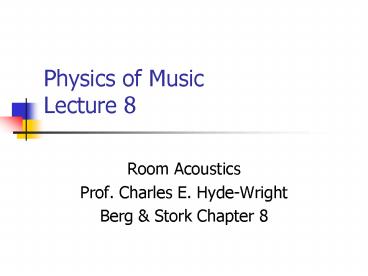Physics of Music Lecture 8 - PowerPoint PPT Presentation
1 / 13
Title:
Physics of Music Lecture 8
Description:
The listener hears both direct sound and (multiply) reflected sound. ... Graduation speeches in SCOPE were incomprehensible. 29 October 2004. Phys332W Lecture 8 ... – PowerPoint PPT presentation
Number of Views:66
Avg rating:3.0/5.0
Title: Physics of Music Lecture 8
1
Physics of MusicLecture 8
- Room Acoustics
- Prof. Charles E. Hyde-Wright
- Berg Stork Chapter 8
2
Reverberation
- Sound bounces off the walls.
- The listener hears both direct sound and
(multiply) reflected sound. - With each bounce, the intensity I0 drops to aI0,
where alt1 is the reflectivity of the wall. - After n-bounces, the intensity is anI0.
Response to a sustained tone
Response to a Sound impulse
3
Exponential Decay of Intensity
- If d is a typical dimension of the room, then the
average time between bounces is d/S, and in a
time t there are n(t S /d) bounces (S speed of
sound). - The sound intensity as a function of time is
- I(t) I0 a(t S /d) exponential decay with
time - Exponential decay law can be written
- I(t) I0 10(-6 t / tR) tR -6 d / S loga
- Reverberation time tR is time for intensity to
decay by 106 (60dB)
4
Reverberation Time
- Exponential decay with time
- I(t) I0 a(t S /d) I0 10(-6 t / tR)
- tR -6 (d/S) / loga
- Dimension d proportional to volume/surface-area
- For a cube, d 6V/A
- Reflectivity a 1-a, aabsorption coefficient
- If altlt1, then loga log(1-a) -a log(2.718)
- tR 55.2 V/(SAeff)
- Aeffa1A1 a2A2
- Ai area of surface i., V volume of room
- ai1-ai absorption coefficient of surface i.
5
Reverberation Time and Absorption CoefficientstR
55.2 V/S (a1A1 a2A2 )
- tR time for the sound intensity to decay by a
factor of 106 60 dB - In time tR/2, sound decays by 30 dB (1/1000)
- In time 2 tR, sound decays by 120 dB (1/1012)
- Notice that reverberation time is frequency
dependent
6
Ideal Reverberation Time
- Speech, Different music styles prefer different
reverberation times.
7
Reverb Time for OCNPS 146
- Front and rear walls 3m x 5m
- Wall board, a(500,2000Hz) (0.1, 0.04)
- Side walls 3m x 15 m
- Floor and ceiling 5m x 15 m
- Concrete a(500,2000Hz) (0.02, 0.02)
- Acoustic board a(500,2000Hz)(0.80,0.90)
- A(500Hz)
- 2(15m2)0.1 2(45m2)0.1 (75m2)0.02
(75m2)0.873.5m2 - tR 55.2 V/(SA) 55.2 (3x5x15m3)/(73.5m2340m/s)
- 0.5 sec
8
Subjective/Objective Qualities in Acoustics
- Liveness
- Long reverb time live
- Short reverb time dead
- Out-of-doors is very dead, tR0
- Intimacy
- How close do the performers seem to be?
- Time delay between direct sound and first reverb.
- Short time delay intimate (sounds like small
room) - Improve intimacy with reflectors close to
musicians. - Reflectors also increase total volume of sound.
9
Fullness / Clarity
- Full sound has a lot of reflected sound
- Slow music prefers fullness
- Clarity implies very little reflected sound
- Speech, fast music requires clarity
- Fullness is almost synonymous with liveness, or
long reverb time.
10
Warmth / Brilliance
- Warmth results when reverb time is longer at low
frequencies than at high frequencies - Fullness in bass, Clarity in treble
- Brilliance is the opposite
- Predominance of high frequencies in reflected
sound - Too much brilliance gives a unpleasant ringing.
- Most soft wall materials (curtains, acoustic
tile) will automatically give warmth, hard wall
materials give brilliance (Table 8-3)
11
Texture
- Texture is the envelope of the decaying sound
- A smooth envelope requires many closely spaced
reverberations, rather than a few widely spaced
strong echoes. - Smooth texture is obtained by breaking up the
wall and ceiling into many irregular reflecting
surfaces. - OCNPS 200 initially had a very long reverb, with
strong echoes. Mostly cured by adding acoustic
paneling. - Graduation speeches in SCOPE were
incomprehensible.
12
Blend Ensemble
- Blend is uniformity of sound intensity received
by listener from all members of ensemble - Ensemble is the ability of all members of the
orchestra to hear each other - Reflectors near ensemble (remember Intimacy) must
be diffuse or irregular, scattering the sound in
all directions
13
Amplified (live) sound
- Indoors or outdoors, amplified sound should
provide all of the features discussed previously. - Speakers staggered throughout the audience must
have appropriate delay, since electricity travels
faster than sound. - Speakers facing back towards stage can provide
reverb, essential to intimacy, warmth, texture. - Or you can just crank it up to ear-splitting
noise.































